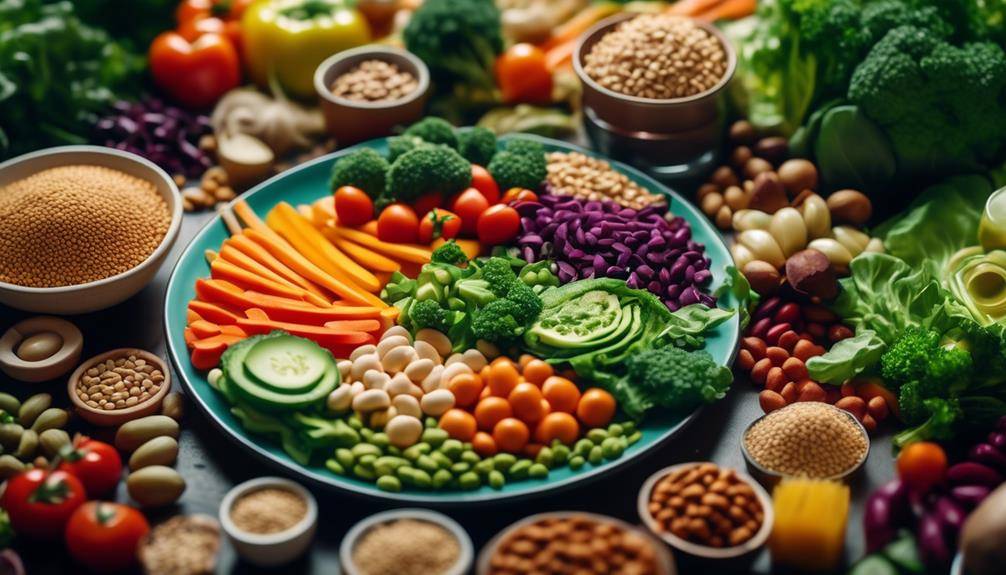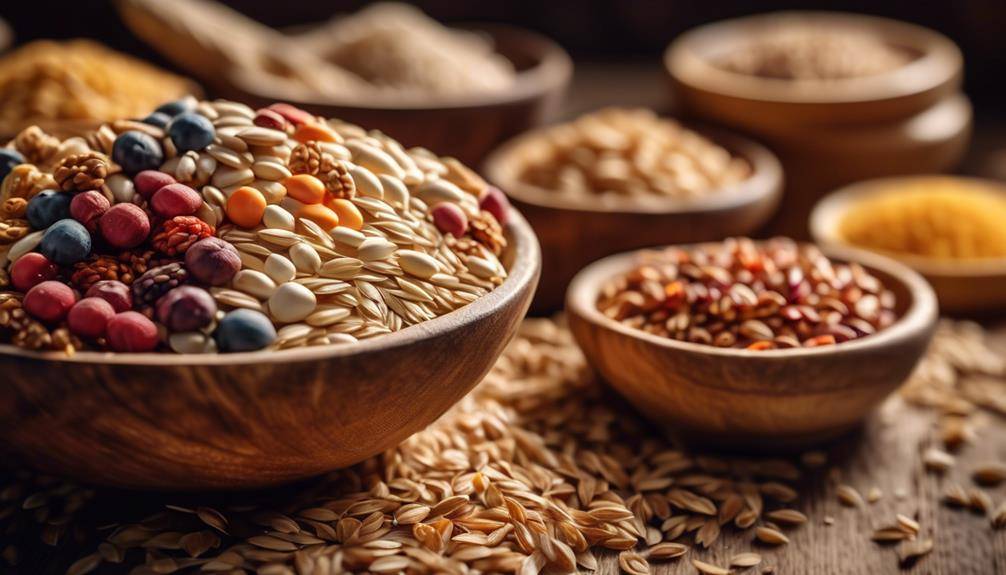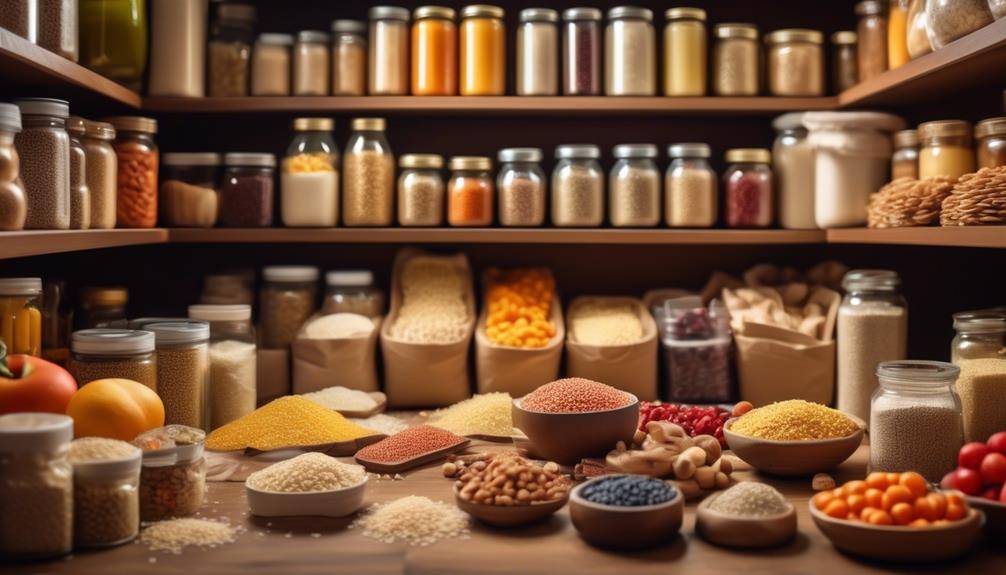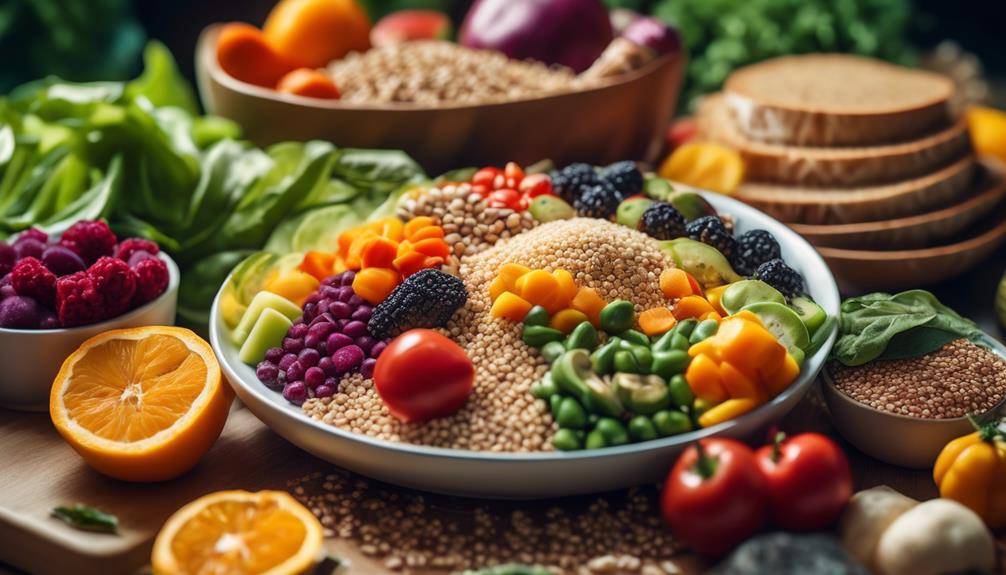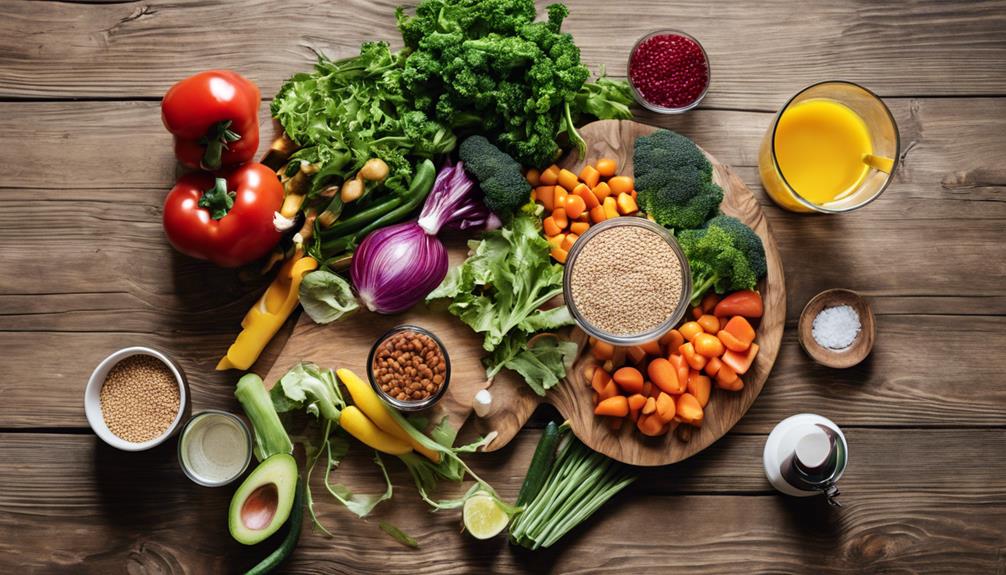The Best Gluten-Free Diet Essential Foods
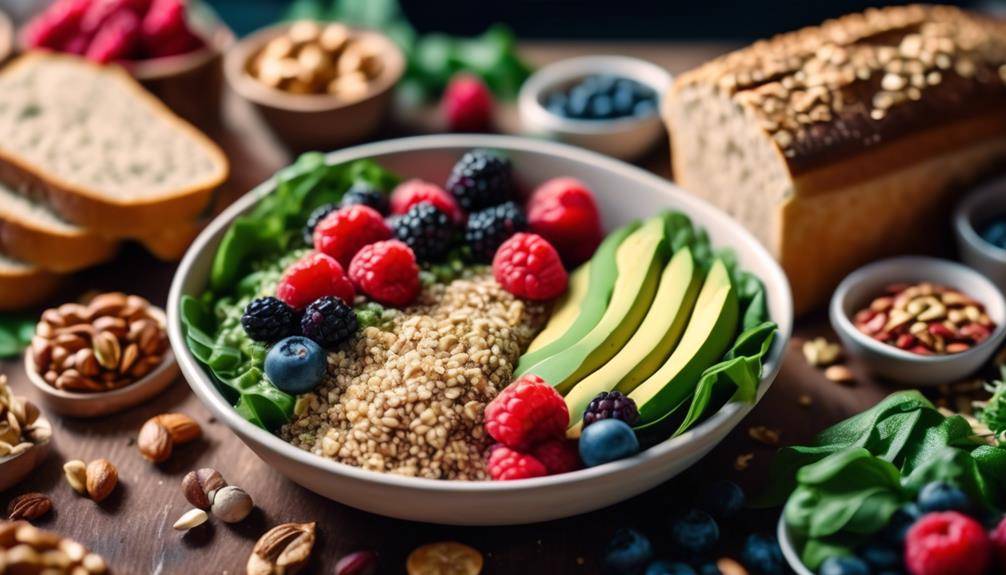
The Best Gluten-Free Diet Essential Foods; Imagine a world where every meal is filled with delicious, satisfying foods that nourish your body and leave you feeling energized. A world where you don’t have to worry about gluten sneaking its way into your diet and causing discomfort. Well, that world is within your reach, and it starts with knowing the essential foods for a gluten-free diet. But what are these foods, you ask? Stick around, because in this discussion, we will uncover the key ingredients that will help you create a flavorful and balanced gluten-free menu.
Fruits and Vegetables
To maintain a gluten-free diet, incorporating a wide variety of nutrient-rich fruits and vegetables is essential. Not only do fruits and vegetables provide vital vitamins and minerals, but they also add flavor and texture to your meals. Filling your plate with these gluten-free foods can help you stay healthy and satisfied.
When it comes to fruits, there are numerous options to choose from. Berries like strawberries, blueberries, and raspberries are packed with antioxidants and fiber. They can be enjoyed as a snack, added to smoothies, or used as toppings for gluten-free desserts. Citrus fruits such as oranges and grapefruits are excellent sources of vitamin C, while bananas provide potassium and dietary fiber. Apples and pears offer a satisfying crunch and are rich in fiber, making them great choices for a gluten-free snack.
Vegetables are equally important in a gluten-free diet. Leafy greens like spinach, kale, and Swiss chard are loaded with essential nutrients like iron, calcium, and vitamins A and C. They can be enjoyed in salads, sautéed as a side dish, or added to gluten-free pasta dishes. Other vegetables like broccoli, carrots, and bell peppers provide a wide range of vitamins and minerals. They can be roasted, steamed, or stir-fried to add variety to your meals.
Incorporating a variety of fruits and vegetables into your gluten-free diet not only ensures that you are getting essential nutrients, but it also adds color and flavor to your meals. Whether you enjoy them raw, cooked, or as part of gluten-free desserts, fruits and vegetables are a delicious and nutritious choice for maintaining a gluten-free lifestyle.
Whole Grains
Including whole grains in your gluten-free diet can provide essential nutrients and add variety to your meals. Contrary to popular belief, a gluten-free diet doesn’t mean you have to give up grains altogether. There are plenty of delicious and nutritious whole grain substitutes that are gluten-free and can be incorporated into your daily meals. Here are four options to consider:
- Quinoa: This ancient grain is not only gluten-free but also packed with protein and fiber. It has a nutty flavor and a versatile texture, making it a great substitute for rice or couscous in various dishes.
- Brown rice: Swap out white rice for brown rice, which retains the bran and germ, providing more nutrients and fiber. Brown rice is a staple in many gluten-free recipes, from stir-fries to pilafs.
- Buckwheat: Despite its name, buckwheat is not related to wheat and is naturally gluten-free. It is rich in antioxidants and has a unique, earthy taste. Use it in pancakes, porridge, or as a flour substitute in gluten-free baking.
- Millet: This small grain is often overlooked but is a powerhouse of nutrients. It is gluten-free, easy to digest, and has a mild, slightly sweet flavor. Millet can be cooked like rice or used as a base for salads and grain bowls.
When it comes to gluten-free baking, there are numerous whole grain flours available as substitutes for wheat flour. Some popular options include brown rice flour, sorghum flour, and almond flour. These flours can be used to make delicious gluten-free bread, muffins, and cookies.
Incorporating whole grains into your gluten-free diet not only provides essential nutrients but also adds texture and flavor to your meals. Explore these whole grain substitutes and experiment with gluten-free baking to create a diverse and satisfying menu.
Legumes and Pulses
When it comes to expanding your gluten-free diet, legumes and pulses offer a nutritious and versatile option. Legumes are a group of plants that include beans, lentils, chickpeas, and peas. They are packed with essential nutrients and provide numerous health benefits.
Legumes are an excellent source of plant-based protein, making them a great alternative for those following a gluten-free diet. They are also rich in fiber, which helps promote digestive health and keeps you feeling fuller for longer. Including legumes in your diet can help stabilize blood sugar levels and reduce the risk of chronic diseases such as heart disease and type 2 diabetes.
In addition to their nutritional benefits, legumes are incredibly versatile and can be used in a variety of dishes. From soups and stews to salads and dips, legumes can be incorporated into numerous gluten-free recipes. Try making a hearty lentil soup or a flavorful chickpea curry for a satisfying and nutritious meal.
Furthermore, legumes are budget-friendly and environmentally sustainable. They require fewer resources to grow compared to animal-based protein sources, making them an environmentally friendly choice. Incorporating legumes into your gluten-free diet not only benefits your health but also contributes to a more sustainable food system.
Lean Proteins
Lean proteins are a crucial component of a gluten-free diet, providing essential nutrients for overall health and well-being. When following a gluten-free diet, it is important to choose high protein options that are also low in fat. Here are some lean meat alternatives that you can incorporate into your gluten-free diet:
- Skinless poultry: Chicken and turkey are excellent sources of lean protein. They are low in fat and can be prepared in various ways, such as grilling, baking, or sautéing. Be sure to remove the skin before cooking to reduce the fat content.
- Fish: Fish, such as salmon, tuna, and trout, are not only high in protein but also rich in omega-3 fatty acids, which are beneficial for heart health. Try to include fish in your diet at least twice a week.
- Eggs: Eggs are a versatile and affordable source of lean protein. They can be enjoyed in various ways, such as boiled, scrambled, or made into omelettes. Remember to consume eggs in moderation, as they are also high in cholesterol.
- Legumes: Legumes, including beans, lentils, and chickpeas, are not only gluten-free but also packed with protein and fiber. They are a great option for vegetarians or those looking to reduce their meat consumption. Legumes can be added to soups, salads, or used as a base for vegetarian dishes.
Dairy Alternatives
Dairy alternatives can be a valuable addition to a gluten-free diet, providing options for those who are lactose intolerant or prefer to avoid dairy products. When it comes to dairy alternatives, two popular choices are non-dairy yogurt and plant-based cheese.
Non-dairy yogurt is a great option for those who still want to enjoy the creamy texture and tangy taste of yogurt without the lactose. Made from plant-based ingredients such as soy, coconut, or almonds, non-dairy yogurts can be found in various flavors and can be enjoyed on their own or as a topping for smoothies, granola, or fruit salads. They are also a good source of probiotics, which can promote a healthy gut.
For those who love cheese but can’t tolerate dairy, plant-based cheese is a fantastic alternative. These cheeses are typically made from nuts, seeds, or soy, and they come in a wide range of flavors and textures. Whether you’re looking for a sharp cheddar, a creamy mozzarella, or a tangy feta, there’s a plant-based cheese out there for you. They can be used in sandwiches, pizzas, pasta dishes, or even enjoyed on their own as a snack.
When choosing dairy alternatives, it’s important to read the labels and check for any hidden sources of gluten. Some dairy alternatives may contain gluten-containing ingredients, such as wheat or barley. Look for products that are certified gluten-free to ensure they meet your dietary needs.
Nuts and Seeds
If you’re looking to explore more options for your gluten-free diet, consider incorporating nuts and seeds into your meals and snacks. Not only are nuts and seeds naturally gluten-free, but they also offer a range of health benefits. Here are four reasons why you should include nuts and seeds in your gluten-free baking and overall diet:
- Nutrient-rich: Nuts and seeds are packed with essential nutrients like healthy fats, protein, fiber, vitamins, and minerals. They can provide you with energy and help support overall health and well-being.
- Versatility: Nuts and seeds can be used in various gluten-free recipes, such as bread, cookies, and granola. They add a delicious crunch and enhance the flavor of your baked goods. You can also enjoy them as a topping for salads, yogurt, or smoothie bowls.
- Gluten-free baking substitutes: Ground nuts and seeds can be used as a substitute for traditional flours in gluten-free baking. Almond flour, for example, is a popular choice for making gluten-free cakes and muffins. Chia seeds and flaxseeds can be used as egg substitutes in recipes, making them suitable for vegan and gluten-free diets.
- Health benefits: Nuts and seeds have been associated with numerous health benefits, including improved heart health, reduced inflammation, and better blood sugar control. They are also rich in antioxidants, which help protect your cells from damage.
Incorporating nuts and seeds into your gluten-free diet can not only add variety to your meals but also provide you with essential nutrients and health benefits. So go ahead and start experimenting with these nutritious ingredients in your gluten-free baking and cooking endeavors.
Healthy Fats and Oils
Incorporating healthy fats and oils into your gluten-free diet is essential for overall health and well-being. Healthy oils, such as olive oil, coconut oil, and avocado oil, provide important nutrients and contribute to a balanced diet. These oils are rich in monounsaturated fats, which have been shown to have numerous health benefits.
Omega-3 fats are a type of healthy fat that are particularly important for brain health and may help reduce inflammation in the body. They can be found in fatty fish like salmon, mackerel, and sardines, as well as in walnuts and flaxseeds. Including these foods in your diet can help ensure that you are getting enough omega-3 fats.
When choosing oils for cooking and dressing your food, it is important to select oils that are minimally processed and have a high smoke point. Oils with a high smoke point, such as coconut oil and avocado oil, can withstand higher cooking temperatures without breaking down and releasing harmful compounds.
It is also important to use oils in moderation, as they are high in calories. While healthy oils can be a beneficial part of your gluten-free diet, it is still important to consume them in appropriate amounts to maintain a healthy weight.
Herbs and Spices
To enhance the flavor and nutritional value of your gluten-free dishes, incorporating a variety of herbs and spices is a great way to add depth and complexity. Not only do herbs and spices make your meals taste delicious, but they also offer numerous health benefits. Here are four essential herbs and spices to include in your gluten-free cooking repertoire:
- Turmeric: Known for its vibrant yellow color, turmeric contains a powerful compound called curcumin. Curcumin has been shown to have anti-inflammatory and antioxidant properties, making it beneficial for reducing inflammation and boosting immune function. Add a pinch of turmeric to your soups, stews, and roasted vegetables for a flavorful and nutritious boost.
- Cinnamon: This warm and fragrant spice is not only delicious but also has several health benefits. Cinnamon has been shown to help regulate blood sugar levels, improve insulin sensitivity, and reduce the risk of heart disease. Sprinkle some cinnamon on your gluten-free oatmeal, add it to your smoothies, or use it in baked goods for a touch of sweetness and a healthful kick.
- Basil: A staple in Mediterranean cuisine, basil adds a fresh and aromatic flavor to dishes. It is rich in antioxidants and has antibacterial properties. Basil can be used in pasta sauces, salads, and even infused into oils for a fragrant drizzle over roasted vegetables or gluten-free pizzas.
- Ginger: Known for its zesty and spicy flavor, ginger has long been used for its medicinal properties. It can help alleviate nausea, reduce inflammation, and improve digestion. Use freshly grated ginger in stir-fries, dressings, or steep it in hot water for a soothing ginger tea.
Incorporating these herbs and spices into your gluten-free cooking not only enhances the taste of your dishes but also provides a range of health benefits. Experiment with different combinations and cooking techniques to create flavorful and nutritious meals that will leave you satisfied and nourished.
Gluten-Free Pasta and Bread
Now let’s talk about gluten-free pasta and bread. There are various types of gluten-free pasta available, such as rice, corn, or quinoa-based options. Gluten-free bread also offers benefits like being easier to digest and reducing inflammation. When cooking gluten-free pasta, make sure to follow the instructions carefully to achieve the desired texture. Similarly, when using gluten-free bread, it’s important to toast or warm it up to enhance its taste and texture.
Types of Gluten-Free Pasta
Discover a variety of delicious gluten-free pasta options that will satisfy your cravings without compromising your dietary needs. Here are four types of gluten-free pasta to try, along with cooking tips to ensure a perfect meal:
- Brown rice pasta: Made from brown rice flour, this pasta has a slightly nutty flavor and a firm texture. Cook it al dente to prevent it from becoming mushy.
- Quinoa pasta: This pasta is made from quinoa flour, which gives it a delicate and nutty taste. Cook it for the recommended time to maintain its texture and prevent it from becoming too soft.
- Corn pasta: Made from corn flour, this pasta has a slightly sweet taste. Be careful not to overcook it, as it can become sticky.
- Lentil pasta: Made from lentil flour, this pasta is a great source of protein and fiber. Cook it for a shorter time to maintain its firmness.
Remember to follow the cooking instructions on the package for the best results. Enjoy your gluten-free pasta dishes without sacrificing taste or texture!
Benefits of Gluten-Free Bread
If you’re already enjoying the variety of gluten-free pasta options, you’ll be pleased to know that gluten-free bread offers its own unique benefits. One of the main benefits of gluten-free bread is that it allows individuals with gluten sensitivities or celiac disease to still enjoy the taste and texture of bread without experiencing any adverse reactions. Gluten-free bread is made with alternative flours such as rice flour, almond flour, or tapioca flour, which do not contain gluten.
Additionally, gluten-free bread can be a healthier option for those who are looking to reduce their gluten intake or follow a gluten-free diet for other health reasons. It can be a great source of fiber, vitamins, and minerals. There are also many gluten-free bread recipes available that allow you to bake your own delicious bread at home, giving you the freedom to customize it to your taste and dietary needs. So, if you’ve been missing bread on your gluten-free diet, give gluten-free bread a try and enjoy its many benefits.
Cooking Tips for Gluten-Free Pasta and Bread
To ensure optimal results when cooking gluten-free pasta and bread, follow these helpful tips:
- Choose the right gluten-free pasta: Look for varieties made from alternative grains like rice, corn, or quinoa. These options have a better texture and taste compared to those made from just one gluten-free flour.
- Cook pasta al dente: Gluten-free pasta tends to become mushy if overcooked. Be sure to follow the recommended cooking time and start checking for doneness a minute or two earlier.
- Add salt to pasta water: Just like regular pasta, adding salt to the boiling water enhances the flavor of gluten-free pasta.
- Experiment with gluten-free bread recipes: Gluten-free bread can be tricky to make, but don’t be afraid to experiment with different recipes. Try using a combination of gluten-free flours like almond, coconut, or tapioca to achieve a better texture and taste.
Non-Dairy Milk
Non-dairy milk provides a nutritious alternative for those following a gluten-free diet. For individuals who are lactose intolerant, allergic to dairy, or choose to follow a plant-based diet, non-dairy milk alternatives offer a wide range of benefits. These alternatives are made from various sources such as nuts, seeds, grains, or legumes, providing a diverse selection to suit different tastes and dietary needs.
One of the main benefits of non-dairy milk is that it is naturally gluten-free. This makes it an excellent choice for individuals with celiac disease or gluten sensitivity who need to eliminate gluten from their diet. Additionally, non-dairy milk alternatives are often fortified with essential nutrients such as calcium, vitamin D, and vitamin B12, which are important for maintaining strong bones and overall health.
Another advantage of non-dairy milk is that it can be easily incorporated into various recipes. Whether you’re making smoothies, baking desserts, or preparing savory dishes, non-dairy milk can be used as a substitute for cow’s milk without compromising taste or texture. It adds a creamy consistency and can enhance the flavor of your favorite dishes.
Furthermore, non-dairy milk alternatives are often lower in calories and fat compared to cow’s milk. This can be beneficial for individuals looking to manage their weight or reduce their saturated fat intake. Moreover, non-dairy milk options are typically cholesterol-free, making them a heart-healthy choice.
When choosing non-dairy milk, it’s important to read the labels and select options that are fortified with nutrients like calcium and vitamin D. Additionally, consider your taste preferences and any allergies or dietary restrictions you may have. With the wide variety of non-dairy milk alternatives available today, you can find the perfect choice to enjoy in your favorite recipes or as a refreshing beverage on its own.
Fermented Foods
Fermented foods offer a wide range of health benefits and can be a delicious addition to a gluten-free diet. Incorporating fermented foods into your diet can provide you with probiotics, which are beneficial bacteria that support gut health and digestion. Here are four fermented foods that you can enjoy on a gluten-free diet:
- Yogurt: Yogurt is a popular fermented food that is rich in probiotics. Look for yogurt that is labeled gluten-free to ensure it is safe for your diet. You can enjoy it plain or add fruits and nuts for added flavor and texture.
- Sauerkraut: Sauerkraut is made by fermenting cabbage and is a great source of probiotics. It can be enjoyed as a side dish or added to sandwiches and salads for a tangy kick.
- Kimchi: Kimchi is a traditional Korean dish made from fermented vegetables, such as cabbage and radishes. It is packed with probiotics and adds a spicy and flavorful element to dishes. Incorporate kimchi into stir-fries or enjoy it as a side dish.
- Kombucha: Kombucha is a fermented tea that is often flavored with fruits and herbs. It is a refreshing and fizzy beverage that can be enjoyed as a substitute for sugary drinks. Look for gluten-free options when purchasing kombucha.
These fermented foods not only add a unique and delicious taste to your meals but also provide you with the benefits of probiotics. Remember to check labels or make your own fermented foods to ensure they are gluten-free. Incorporating these foods into your gluten-free diet can support your gut health and contribute to overall well-being.
Gluten-Free Snacks
If you’re looking for tasty and gluten-free options to satisfy your snack cravings, there are plenty of delicious choices available. Going gluten-free doesn’t mean you have to give up on snacking. In fact, there are numerous gluten-free snack ideas and recipes that can provide you with both nutrition and flavor.
One popular gluten-free snack idea is to make your own trail mix. You can combine a variety of nuts, seeds, and dried fruits to create a personalized blend. This not only satisfies your cravings but also provides you with a good source of protein and healthy fats. Another option is to make gluten-free energy bites using ingredients like dates, nuts, and nut butter. These little snacks are packed with nutrients and can give you a quick boost of energy.
For those with a sweet tooth, gluten-free cookies and bars are a great choice. There are many recipes available that use alternative flours like almond flour or coconut flour. These treats can be just as delicious as their gluten-containing counterparts.
If you prefer savory snacks, gluten-free crackers and chips are readily available in stores. You can also make your own kale chips by baking kale leaves until they become crispy. These are a healthy and flavorful alternative to regular chips.
Frequently Asked Questions: The Best Gluten-Free Diet Essential Foods
Are There Any Specific Fruits and Vegetables That Should Be Avoided on a Gluten-Free Diet?
When following a gluten-free diet, it is important to avoid specific fruits and vegetables that may contain hidden sources of gluten. Always read labels and be cautious when dining out to maintain a gluten-free lifestyle.
Can I Consume Whole Grain Products That Are Labeled as “Gluten-Free”?
Yes, you can consume whole grain products labeled as ‘gluten-free’. These products are made from gluten-free grain substitutes, such as quinoa or brown rice. However, be cautious of potential risks and always read labels carefully.
What Are Some Common Legumes and Pulses That Are Naturally Gluten-Free?
You can find a variety of naturally gluten-free legumes and pulses, such as lentils, chickpeas, and black beans. These can be great additions to your gluten-free recipes and provide essential nutrients. When dining out on a gluten-free diet, be sure to ask about any potential cross-contamination risks.
Are All Types of Lean Proteins Suitable for a Gluten-Free Diet?
Lean proteins such as chicken, fish, and lean cuts of beef are suitable for a gluten-free diet. They provide essential nutrients and can help with weight management and muscle growth. Incorporating them into your diet can have numerous health benefits.
Can I Still Enjoy Traditional Dairy Products if I’m Following a Gluten-Free Diet?
You can still enjoy traditional dairy products while following a gluten-free diet. However, if you have lactose intolerance or want dairy substitutions, there are plenty of options available. Additionally, there are gluten-free baking alternatives for your favorite dairy-based recipes.
Conclusion
In conclusion, following a gluten-free diet can be achieved by incorporating essential foods such as fruits, vegetables, whole grains, legumes, lean proteins, dairy alternatives, gluten-free pasta and bread, non-dairy milk, fermented foods, and gluten-free snacks. These options provide necessary nutrients and variety while eliminating gluten-containing ingredients. By making informed choices and incorporating these foods into their diet, individuals can successfully adhere to a gluten-free lifestyle.



